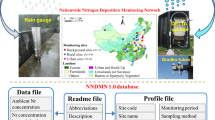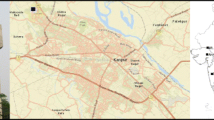Abstract
Annual emission map for NH3, NOX, and SO2 within Osaka prefecture was shown according to the EAGrid2000-Japan emission database. The median emission of NH3, NOX, and SO2 was 1.94, 24.8, 1.32 ton/km2/year, respectively, while that at 11 passive sampling sites was 1.61, 17.3, 0.74 ton/km2/year, respectively. Monthly emission for NH3 showed apparent seasonal trends, being high in summer and low in winter. That for NOX and SO2 was slightly high in winter and low in summer and constant through the year, respectively. Atmospheric concentration of NH3, NO2, HNO3, and SO2 by the passive method was compared with corresponding emission inventory. Average concentrations of HNO3, SO2, NH3, and NO2 in June were 16–67, 23–135, 21–173, and 149–873 nmol/m3, respectively, while those in October were 5–21, 16–72, 14–196, and 169–1,167 nmol/m3, respectively. The emission inventory flux of SO2, NOX, and NH3 was calculated both within 1 × 1- and 3 × 3-km mesh. It was a small difference between June and October for SO2 and NOX in the both meshes. For NH3, emission flux in June was around twofold of that in October. The NH3 correlation between concentration and emission flux was excellent in the 1 × 1 km mesh, although somewhat decreased in the 3 × 3 km mesh. In the case of NO2, the correlation for the 3 × 3 km mesh, however, was more increased than the 1 × 1 km mesh. The correlation for HNO3 and SO2 was a small difference with the both meshes. Monthly concentrations of NH3, NO2, HNO3, and SO2 were compared with their corresponding gases emission at whole-year survey sites. Concentration of NH3 was high from July to November, while emission of NH3 was high from June to September (summer) and low from December to March (winter). Trend of NO2 concentration was high in winter and low in summer, a similar tendency to that of NOX emission. On the other hand, the trend of HNO3 concentration was high in summer and low in winter. There was no particular seasonal trend of SO2 concentration and SO2 emission had also no seasonal variation but was constant.



Similar content being viewed by others
References
Acid Deposition Survey Sectional Meeting of Japan Environmental Laboratories Association. (2005). The report of acid deposition survey in Japan, phase 4. Journal of Japan Environmental Laboratories Association, 30(2), 58–135. in Japanese.
Acid Deposition Survey Sectional Meeting of Japan Environmental Laboratories Association. (2006). The report of acid deposition survey in Japan, phase 4. Journal of Japan Environmental Laboratories Association, 31(3), 118–186. in Japanese.
Acid Deposition Survey Sectional Meeting of Japan Environmental Laboratories Association. (2007). The report of acid deposition survey in Japan, phase 4. Journal of Japan Environmental Laboratories Association, 32(3), 78–152. in Japanese.
Acid Deposition Survey Sectional Meeting of Japan Environmental Laboratories Association. (2008). The report of acid deposition survey in Japan, phase 4. Journal of Japan Environmental Laboratories Association, 33(3), 126–196. in Japanese.
Kannari, A., Yutaka Tonooka, Y., Baba, T., & Murano, K. (2007). Development of multiple-species 1 km × 1 km resolution hourly basis emissions inventory for Japan. Atmospheric Environment, 41, 3428–3439.
Nishikawa, Y., & Hatanaka, H. (2008). Measurement of acidic gases within Osaka prefecture using a simple passive sampling method. Bulletin of Research Institute of Environment, Agriculture and Fisheries, Osaka Prefectural Government, 1, 6–12. in Japanese with English abstract.
Nishikawa, Y., Murano, K., & Mukai, H. (2009). Comparison of sampling resistance for one to three sheets of membrane type passive sampler. Water, Air, and Soil Pollution, 197, 241–247.
Tokai-Kinki-Hokuriku Branch of Japan Environmental Laboratories Association. (2004). Examination for practical use of simple passive sampling methods—collaborative investigation by Tokai-Kinki-Hokuriku branch of environmental laboratories association in Japan. Journal of Japan Environmental Laboratories Association, 29(1), 25–35. in Japanese with English abstract.
Acknowledgements
The authors express appreciation to environmental section staff of local government who participated in the acid deposition survey network in Osaka prefecture, with their labor for sampling and transport of the passive sampler.
This work was presented at the 15th International Joint Seminar on the Regional Deposition Processes in the Atmosphere, Taipei, Taiwan, ROC, on 12–14 November 2009.
Author information
Authors and Affiliations
Corresponding author
Rights and permissions
About this article
Cite this article
Nishikawa, Y., Kannari, A. Atmospheric Concentration of Ammonia, Nitrogen Dioxide, Nitric Acid, and Sulfur Dioxide by Passive Method within Osaka Prefecture and Their Emission Inventory. Water Air Soil Pollut 215, 229–237 (2011). https://doi.org/10.1007/s11270-010-0472-3
Received:
Accepted:
Published:
Issue Date:
DOI: https://doi.org/10.1007/s11270-010-0472-3




